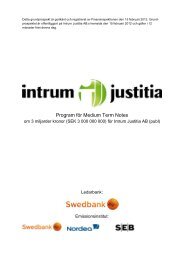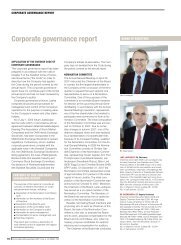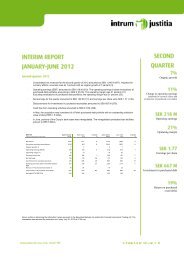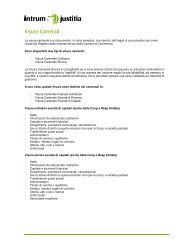ANNUAL REPORT INTRUM JUSTITIA A N N U A L R EP O R T 2 0 ...
ANNUAL REPORT INTRUM JUSTITIA A N N U A L R EP O R T 2 0 ...
ANNUAL REPORT INTRUM JUSTITIA A N N U A L R EP O R T 2 0 ...
You also want an ePaper? Increase the reach of your titles
YUMPU automatically turns print PDFs into web optimized ePapers that Google loves.
iod of employment of the employees covered by<br />
the plan. Actuarial gains and losses are otherwise<br />
not taken into account.<br />
The carrying value of pensions and similar<br />
obligations recognized in the balance sheet corresponds<br />
to the present value of the obligations<br />
on the balance sheet date less the fair value of investment<br />
assets, unrecognized actuarial gains and<br />
losses and unrecognized costs for service during<br />
previous periods.<br />
All the components included in the costs for the<br />
period for a defined benefit plan are recognized in<br />
operating profit.<br />
Pension obligations in Sweden that are met<br />
through pension insurance premiums to Alecta<br />
in the so-called ITP plan are reported as defined<br />
contribution pension solutions.<br />
Share-based payment<br />
The Group has issued employee stock options,<br />
including so-called performance shares, to senior<br />
executives, which may require the issuance of<br />
shares in Intrum Justitia AB.<br />
An option program gives employees the opportunity<br />
to acquire shares in the company. The<br />
fair value of the allotted options is recognized as<br />
a staff cost with a corresponding increase in equity.<br />
Fair value is initially calculated at the time<br />
of allotment and distributed over the vesting<br />
period. The fair value of the allotted options is<br />
calculated according to the Black-Scholes model<br />
and takes into account the terms and conditions<br />
of the allotted instruments. The recognized cost<br />
corresponds to the fair value of an estimate of<br />
the number of options earned. This cost is adjusted<br />
in subsequent periods to reflect the actual<br />
number of options earned.<br />
Social security expenses attributable to sharebased<br />
payment issued to employees as compensation<br />
for services rendered are expensed in the<br />
periods the services are rendered. The provision<br />
for social security expenses is based on the fair<br />
value of the options on the reporting date. Fair<br />
value is calculated with the same valuation model<br />
used when the options were issued.<br />
Borrowing costs<br />
The Group applies IAS 23 Borrowing Costs.<br />
Costs to secure bank financing are distributed<br />
across the term of the loan as financial expenses in<br />
the consolidated income statement. The amount<br />
is recognized in the balance sheet as a deduction<br />
to the loan liability.<br />
The Group and Parent Company capitalize borrowing<br />
costs in the cost of qualified assets effective<br />
January 1, 2009. In terms of amount, qualified assets<br />
are material fixed assets with long completion<br />
times. No such investments were made in 2010.<br />
Revenue recognition<br />
The Group applies IAS 18 Revenue.<br />
Revenue, consisting of commissions and collection<br />
fees, is recognized on collection of the<br />
debt. Subscription revenue is recognized proportionately<br />
over the term of the underlying service<br />
contracts, which is usually one year.<br />
Financial income and expenses<br />
Financial income and expenses consist of interest<br />
income on bank balances and receivables and<br />
interest-bearing securities, bank fees, interest expenses<br />
on loans, dividend income, exchange rate<br />
differences, realized and unrealized gains on financial<br />
investments, and derivatives used in financial<br />
operations.<br />
Purchased debt<br />
Purchased debt consists of portfolios of delinquent<br />
consumer debts purchased at prices significantly<br />
below the nominal receivable. They are<br />
recognized according to the rules for loans and<br />
receivables in IAS 39, i.e., at amortized cost according<br />
to the effective interest model.<br />
Revenues from purchased debt are recognized<br />
through profit or loss as the collected amount<br />
less amortization. The collection is performed by<br />
the same personnel who handle collections and<br />
debt surveillance on behalf of external clients<br />
within the Credit Management service line. The<br />
cost of collection is debited internally at market<br />
price and expensed in the income statement<br />
for the Purchased Debt service line as a cost of<br />
services sold.<br />
Reporting follows the effective interest method,<br />
where the carrying value of each portfolio corresponds<br />
to the present value of all forecast future<br />
cash flows discounted by an initial effective interest<br />
rate determined on the date the portfolio was<br />
acquired, based on the relation between cost and<br />
the forecast future cash flows on the acquisition<br />
date. Changes in the carrying value of the portfolios<br />
are comprised of amortization for the period<br />
and are recognized through profit or loss on the<br />
revenue line.<br />
In connection with the purchase of each portfolio<br />
of receivables, a forecast is made of the portfolio’s<br />
forecast cash flows. Cash flows include the<br />
loan amount, reminder fees, collection fees and<br />
late interest that, based on a probability assessment,<br />
are expected to be received from debtors,<br />
less forecast collection costs. With this forecast<br />
and the purchase price including transaction<br />
costs as a basis, each portfolio is assigned an<br />
initial effective interest rate that is then used to<br />
discount cash flows through the life of the portfolio.<br />
Current cash flow forecasts are monitored<br />
over the course of the year and updated based on,<br />
among other things, achieved collection results,<br />
agreements reached with debtors on installment<br />
plans and macroeconomic information. Cash<br />
flow forecasts are made at the portfolio level,<br />
since each portfolio of receivables consists of a<br />
small number of homogeneous amounts. On<br />
the basis of the updated cash flow forecasts and<br />
initial effective interest rate, a new carrying value<br />
for the portfolio is calculated in the closing accounts.<br />
The Group applies internal application<br />
rules which mean that the initial effective interest<br />
rate can be adjusted in certain cases without<br />
a change in the carrying value of the portfolio<br />
for minor forecasts adjustments within a predetermined<br />
interval. Changes over time in the book<br />
value can be divided into a time and interest rate<br />
component and a component related to changes<br />
in estimates of future cash flows. Changes in cash<br />
flow forecasts are treated symmetrically, i.e., both<br />
increases and decreases in forecast flows affect the<br />
portfolios’ book value and, as a result, earnings.<br />
However, the portfolios are never recognized at<br />
higher than cost.<br />
Notes<br />
Cash flow statement<br />
The Group applies IAS 7 Cash Flow Statements.<br />
The cash flow statement includes changes in the<br />
balance of liquid assets. The Group’s liquid assets<br />
consist of cash and bank balances as well as short<br />
term investments. Cash flow is divided into cash<br />
flows from operating activities, investing activities<br />
and financing activities.<br />
The layout of the cash flow statement has been<br />
changed from previous years by reversing the amortization<br />
of purchased debt in cash flow from<br />
operating activities instead of including it in cash<br />
flow from investing activities.<br />
Cash flow from investing activities includes<br />
only actual disbursements for investments during<br />
the year.<br />
Foreign subsidiaries’ transactions are translated<br />
in the cash flow statement at the average exchange<br />
rate for the period. Acquired and divested subsidiaries<br />
are recognized as cash flow from investing<br />
activities, net, after deducting liquid assets in the<br />
acquired or divested company.<br />
Earnings per share<br />
The Group applies IAS 33 Earnings per Share.<br />
Earnings per share consist of net earnings for<br />
the year (attributable to the Parent Company’s<br />
shareholders) divided by a weighted average<br />
number of shares during the year. Shares issued<br />
or repurchased during the year are included in the<br />
calculation from the date the proceeds from the<br />
transaction are paid to or by Intrum Justitia.<br />
The Group had an employee stock option<br />
program for which the Parent Company issued<br />
options to senior executives in the Group to subscribe<br />
for shares at a predetermined price during<br />
the period July 1, 2007–May 30, 2009. In 2009<br />
the employee stock option program gave rise to a<br />
dilution effect on earnings per share corresponding<br />
to unexercised options calculated according to<br />
IAS 33. The dilution effect consists of the difference<br />
between the number of options exercised and<br />
the number of shares at market value corresponding<br />
to the subscription proceeds. A Performance-<br />
Based Share Program was introduced in 2008, but<br />
has not yet caused any dilution effect since the<br />
conditions regarding growth in earnings per share,<br />
for example, have not yet been met.<br />
Segments<br />
The Group applies IFRS 8 Operating Segments.<br />
An operating segment is a part of the Group<br />
from which it can generate revenues and incur expenses<br />
and for which separate financial information<br />
is available that is evaluated regularly by the<br />
chief operating decision maker in deciding how to<br />
assess performance and allocate resources to the<br />
operating segment.<br />
Intrum Justitia’s operating segments are the<br />
geographical regions Northern Europe (Denmark,<br />
Estonia, Finland, Latvia, Lithuania, Norway, Poland,<br />
Russia and Sweden), Central Europe (Austria,<br />
Czech Republic, Germany, Hungary, Slovakia<br />
and Switzerland) and Western Europe (Belgium,<br />
France, Ireland, Italy, Netherlands, Portugal,<br />
Spain and United Kingdom). In 2009 the Group<br />
reported in seven regions that were merged to<br />
three in 2010. The comparison numbers for 2009<br />
are presented according to the new regions. Central<br />
and common expenses are not distributed to<br />
57
















